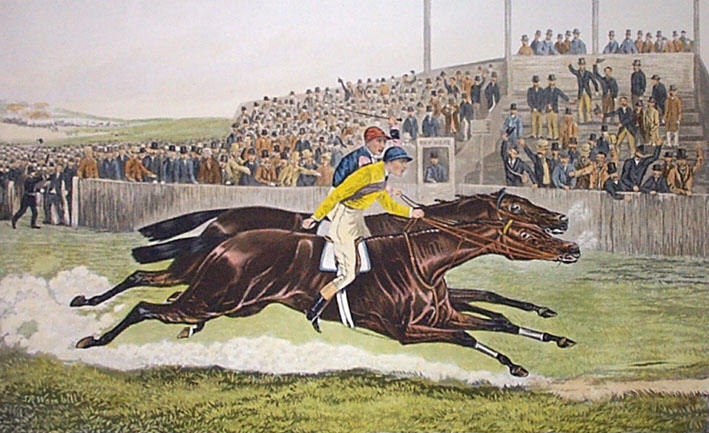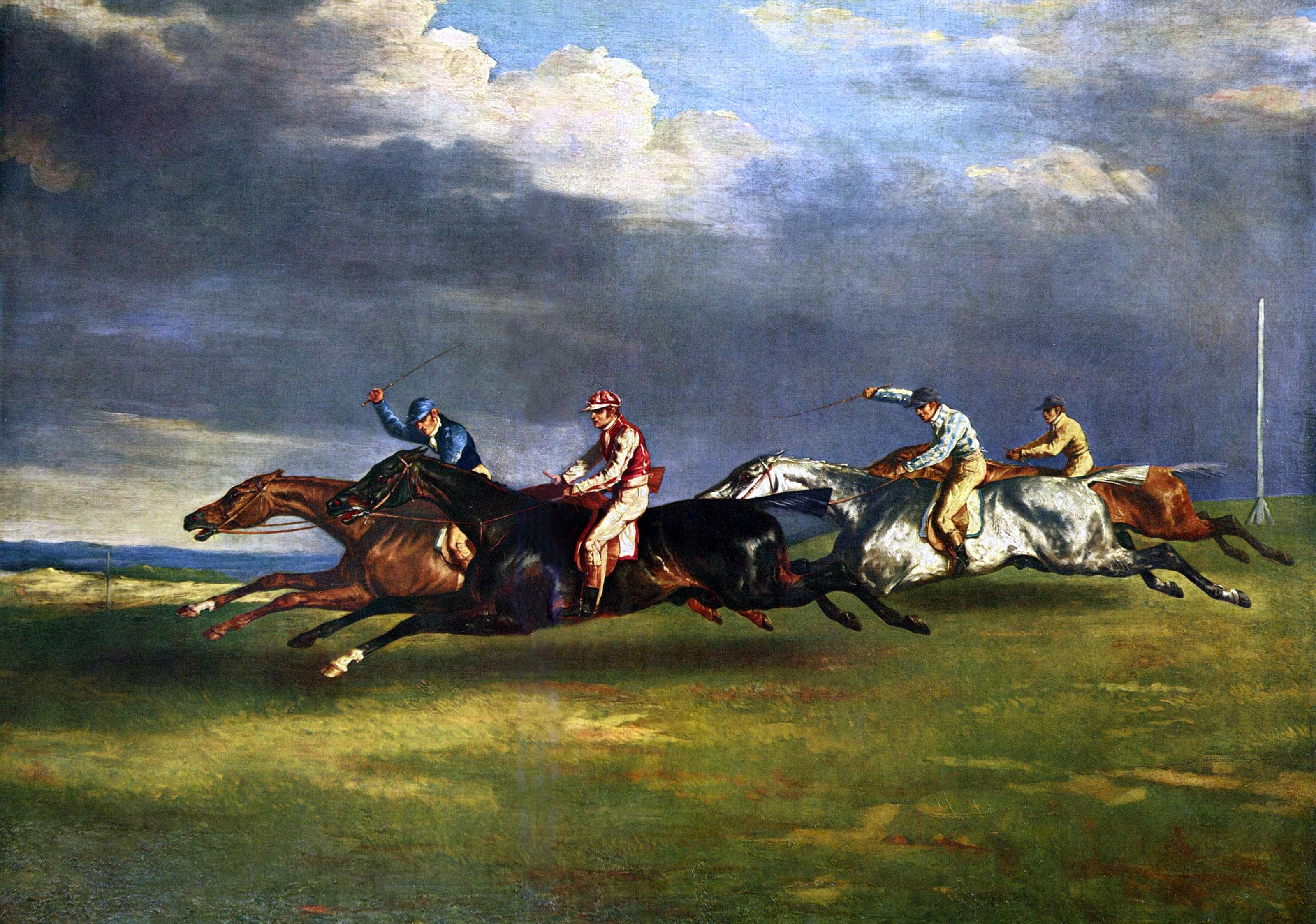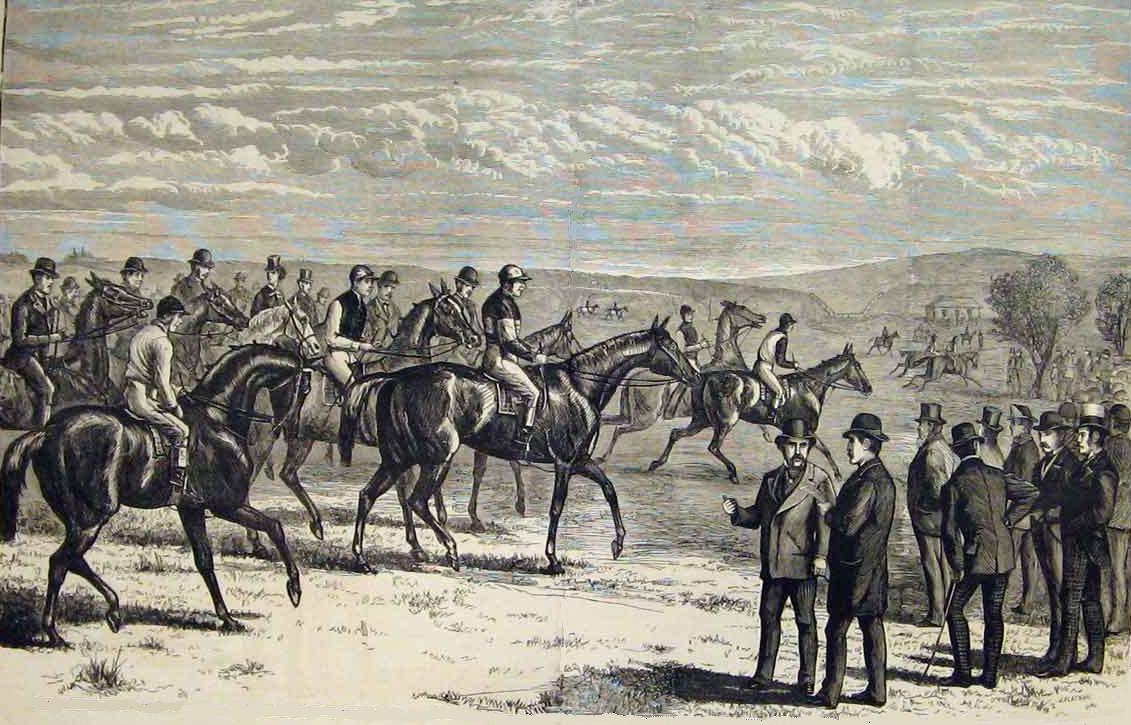|
Paradox (horse)
Paradox (1882–1890) was a British Thoroughbred racehorse and sire. In a career that lasted from October 1884 until October 1885 he ran eight times and won six races. Despite running only twice in 1884, he proved himself to be one of the best two-year-olds of his generation by winning the Dewhurst Plate. In the following year he won five of his six races including the 2,000 Guineas, the Grand Prix de Paris, the Sussex Stakes and the Champion Stakes. His only defeat came when he was narrowly beaten by Melton in The Derby. The final phase of the colt's racing career was marked by controversy and recrimination following his withdrawal from the Cambridgeshire Handicap in the autumn of 1885 and he was retired from racing in 1886. Paradox had little opportunity to establish himself at stud, dying in 1890 at the age of eight. Background Paradox was a strongly-built bay horse bred by the Graham brothers at the Yardley Stud near Birmingham. He was sired by the 2,000 Guineas ru ... [...More Info...] [...Related Items...] OR: [Wikipedia] [Google] [Baidu] |
Lowes Cato Dickinson
Lowes Cato Dickinson (27 November 1819 – 15 December 1908) was an English portrait painter and Christian socialist. He taught drawing with John Ruskin and Dante Gabriel Rossetti. He was a founder of the Working Men's College in London.Lowes Cato Dickinson National Portrait Gallery, accessed January 2010 Life Dickinson was born in and was one of eleven siblings. He obtained his first apprenticeship with his father, a Bond Street lithographer and art publisher, after attending Topsham School, and Dr Lord's School in Tooting.[...More Info...] [...Related Items...] OR: [Wikipedia] [Google] [Baidu] |
Epsom Derby
The Derby Stakes, also known as the Epsom Derby or the Derby, and as the Cazoo Derby for sponsorship reasons, is a Group 1 flat horse race in England open to three-year-old colts and fillies. It is run at Epsom Downs Racecourse in Surrey on the first Saturday of June each year, over a distance of one mile, four furlongs and 6 yards (2,420 metres). It was first run in 1780. It is Britain's richest flat horse race, and the most prestigious of the five Classics. It is sometimes referred to as the "Blue Riband" of the turf. The race serves as the middle leg of the historically significant Triple Crown of British horse racing, preceded by the 2000 Guineas and followed by the St Leger, although the feat of winning all three is rarely attempted in the modern era due to changing priorities in racing and breeding, and the demands it places on horses. The name "Derby" (deriving from the sponsorship of the Earl of Derby) has been borrowed many times, notably by the Kentucky D ... [...More Info...] [...Related Items...] OR: [Wikipedia] [Google] [Baidu] |
Fractional Odds
Odds provide a measure of the likelihood of a particular outcome. They are calculated as the ratio of the number of events that produce that outcome to the number that do not. Odds are commonly used in gambling and statistics. Odds also have a simple relation with probability: the odds of an outcome are the ratio of the probability that the outcome occurs to the probability that the outcome does not occur. In mathematical terms, where p is the probability of the outcome: :\text = \frac where 1-p is the probability that the outcome does not occur. Odds can be demonstrated by examining rolling a six-sided die. The odds of rolling a 6 is 1:5. This is because there is 1 event (rolling a 6) that produces the specified outcome of "rolling a 6", and 5 events that do not (rolling a 1,2,3,4 or 5). The odds of rolling either a 5 or 6 is 2:4. This is because there are 2 events (rolling a 5 or 6) that produce the specified outcome of "rolling either a 5 or 6", and 4 events that do n ... [...More Info...] [...Related Items...] OR: [Wikipedia] [Google] [Baidu] |
Middle Park Stakes
The Middle Park Stakes is a Group 1 flat horse race in Great Britain open to two-year-old colts. It is run on the Rowley Mile at Newmarket over a distance of 6 furlongs (1,207 metres), and it is scheduled to take place each year in September. History The event was founded by William Blenkiron, and it is named after his stud at Eltham. It was established in 1866, and was initially titled the Middle Park Plate. It was originally open to horses of either gender. The race was formerly staged during Newmarket's Cambridgeshire Meeting in late September or early October. It was restricted to colts in 1987. It became part of a new fixture called Future Champions Day in 2011. From 2015, the Middle Park Stakes was moved from Future Champions Day and brought forward two weeks, returning to the Cambridgeshire meeting, to avoid a clash with the similar Dewhurst Stakes. The Middle Park Stakes was added to the Breeders' Cup Challenge series in ... [...More Info...] [...Related Items...] OR: [Wikipedia] [Google] [Baidu] |
Kingsclere
Kingsclere is a large village and civil parish in Hampshire, England. Geography Kingsclere is approximately equidistant ) from the towns of Basingstoke and Newbury on the A339 road. History Kingsclere can trace back its history to a place identified as belonging to King Alfred in his will between 872 and 888, the 'clere' possibly meaning 'bright' or 'clearing'. Kingsclere formed part of the ancient demesne of the Crown. In his will King Alfred left Kingsclere for life to his second daughter, Ethelgiva, Abbess of Shaftesbury, and there are other mentions of it in Saxon charters. In 931 King Athelstan at a Witenagemot at Colchester granted 10 hides of land at Clere to Abbot Aelfric, and in 943 King Edmund bestowed 15 hides of land at Clere on the 'religious woman Aelfswith'. While sixteen years later King Edgar gave his thegn Aelfwine 10 hides of land at West Clere. Local legend asserts that King John was troubled by a bedbug during a night in a Kingsclere inn, whe ... [...More Info...] [...Related Items...] OR: [Wikipedia] [Google] [Baidu] |
Guinea (British Coin)
The guinea (; commonly abbreviated gn., or gns. in plural) was a coin, minted in Great Britain between 1663 and 1814, that contained approximately one-quarter of an ounce of gold. The name came from the Guinea region in West Africa, from where much of the gold used to make the coins was sourced. It was the first English machine-struck gold coin, originally representing a value of 20 shillings in sterling specie, equal to one pound, but rises in the price of gold relative to silver caused the value of the guinea to increase, at times to as high as thirty shillings. From 1717 to 1816, its value was officially fixed at twenty-one shillings. In the Great Recoinage of 1816, the guinea was demonetised and the word "guinea" became a colloquial or specialised term. Although the coin itself no longer circulated, the term ''guinea'' survived as a unit of account in some fields. Notable usages included professional fees (medical, legal, etc.), which were often invoiced in guineas, and h ... [...More Info...] [...Related Items...] OR: [Wikipedia] [Google] [Baidu] |
Yearling (horse)
A yearling is a young horse either male or female that is between one and two years old.Ensminger, M. E. ''Horses & Tack: A Complete One Volume Reference on Horses and Their Care'' Rev. ed. Boston:Houghton Mifflin Co. 1991 p. 470 Yearlings are comparable in development to a very early adolescent and are not fully mature physically. While they may be in the earliest stages of sexual maturity, they are considered too young to be breeding stock. Yearlings may be further defined by sex, using the term "colt" to describe any male horse under age four, and filly for any female under four. Development and training Generally, the training of yearlings consists of basic gentling on the ground; most are too young to be ridden or driven. Yearlings are often full of energy and quite unpredictable. Even though they are not fully mature, they are heavier and stronger than a human and require knowledgeable handling. Many colts who are not going to be used as breeding stallions are gelded ... [...More Info...] [...Related Items...] OR: [Wikipedia] [Google] [Baidu] |
Royal Palace (horse)
Royal Palace (1964–1991) was a British Thoroughbred racehorse. In a racing career which lasted from June 1966 until July 1968 he ran eleven times and won nine races. After being rated the best English-trained two-year-old of 1966, he won the first two legs of the Triple Crown, the 2000 Guineas and the Derby in 1967. He returned for an unbeaten four-year-old season in 1968 when he won four races which are now Group One events. Background Royal Palace was a dark-coated bay horse with a white star and one white foot, bred and raced by Jim Joel, whose father and uncle were both major forces in British horse racing. He was sired by Ballymoss, the leading European racehorse of 1958 and a grandson of one of the most influential stallions in history, Nearco. His dam Crystal Palace was a successful racemare who won the Falmouth Stakes and the Nassau Stakes in 1959. She was also an important broodmare, producing Prince Consort ( Princess of Wales's Stakes), Selhurst, ( Hardwicke S ... [...More Info...] [...Related Items...] OR: [Wikipedia] [Google] [Baidu] |
Humorist (horse)
Humorist (1918–1921) was a British Thoroughbred racehorse. He was a leading two-year-old in 1920 and finished third in the 1921 2000 Guineas before winning the Derby at Epsom. Less than three weeks after the Derby, Humorist died in his stable from a lung haemorrhage caused by a tubercular condition. Background Humorist was a "beautiful, rather delicate" chestnut colt with a broad white blaze and a “kind and intelligent” temperament. He was bred by his owner Jack Joel, who sent him to his private trainer Charles Morton at Letcombe Bassett in Berkshire. Humorist's sire, Polymelus, was a good racehorse who won the Champion Stakes in 1906, but went on to much greater success as a stallion. Apart from Humorist, he sired the Derby winners Pommern and Fifinella and through his son Phalaris is the direct male-line ancestor of most modern thoroughbreds. Humorist's dam, Jest was a highly successful racemare, winning the 1000 Guineas and the Oaks in 1913, and was a half sist ... [...More Info...] [...Related Items...] OR: [Wikipedia] [Google] [Baidu] |
Archibald Primrose, 5th Earl Of Rosebery
Archibald Philip Primrose, 5th Earl of Rosebery, 1st Earl of Midlothian, (7 May 1847 – 21 May 1929) was a British Liberal Party politician who served as Prime Minister of the United Kingdom from March 1894 to June 1895. Between the death of his father, in 1851, and the death of his grandfather, the 4th Earl of Rosebery, in 1868, he was known by the courtesy title of Lord Dalmeny. Rosebery first came to national attention in 1879 by sponsoring the successful Midlothian campaign of William Ewart Gladstone. He briefly was in charge of Scottish affairs. His most successful performance in office came as chairman of the London County Council in 1889. He entered the cabinet in 1885 and served twice as foreign minister, paying special attention to French and German affairs. He succeeded Gladstone as prime minister and leader of the Liberal Party in 1894; the Liberals lost the 1895 election. He resigned the party leadership in 1896 and never again held political office. Rosebery ... [...More Info...] [...Related Items...] OR: [Wikipedia] [Google] [Baidu] |
2,000 Guineas Stakes
The 2000 Guineas Stakes is a Group 1 flat race in Great Britain open to three-year-old thoroughbred colts and fillies. It is run on the Rowley Mile at Newmarket over a distance of 1 mile (1,609 metres) and scheduled to take place each year at the start of May. It is one of Britain's five Classic races, and at present it is the first to be run in the year. It also serves as the opening leg of the Triple Crown, followed by the Derby and the St Leger, although the feat of winning all three has been rarely attempted in recent decades. History The 2000 Guineas Stakes was first run on 18 April 1809, and it preceded the introduction of a version for fillies only, the 1000 Guineas Stakes, by five years. Both races were established by the Jockey Club under the direction of Sir Charles Bunbury, who had earlier co-founded the Derby at Epsom. The races were named according to their original prize funds ( ... [...More Info...] [...Related Items...] OR: [Wikipedia] [Google] [Baidu] |






